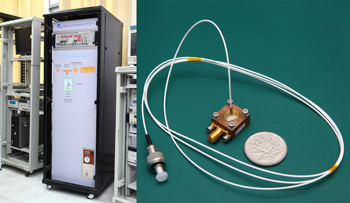Superconducting materials and superconducting electronics applications
Date:09-06-2017 | 【Print】 【close】
Superconducting electronic device has the advantages of high sensitivity, fast speed, low loss and wide bandwidth, etc., and can be applied to the key areas where semiconductor devices are incompetent, with important application prospects in many fields, including population health, information technology,
astronomical observation, mineral resource exploration and national defense construction, etc. With super-high sensitivity detection technology as the starting point, Shanghai Institute of Microsystem and Information Technology (SIMIT) has built the ecological
"Materials - devices - applications" research environment, constructed high-end devices and circuit research platform, cultivated an international R & D team, and conducted comprehensive research on the basis and application of superconducting electronics.
The superconducting laboratory is the eighth research laboratory of SIMIT, which is the main unit of the Center for Excellence in Superconducting Electronics (CENSE) of the Chinese Academy of Sciences and an important part of the State Key Laboratory of Functional Materials for Informatics. The main research directions include: research and development of superconducting quantum devices, exploration of quantum materials such as superconductivity and graphene, and in-situ electronic structure research, etc.
Superconducting Laboratory has led multiple major national scientific research projects, including the Strategic Priority Research Program (B) of the Chinese Academy of Sciences, the special major equipment of Fund Commission, the national major projects and 973 program, etc., with an average annual research funding of more than 70 million yuan. CENSE currently has about 70 scientific research personnel, including 17 researchers and 2 included in the "1000 talents plan" of the Organization Department of the Central Committee of the Communist Party of China, 7 "Hundred-Talent Program" of CAS, over 100 graduate students and other rotators.
After nearly a decade of development, the Superconducting Laboratory has established an internationally competitive superconducting device technology platform and R & D team, forming an innovative train of "Materials, devices and applications". The superconducting nanowire single photon detector has high performance of detection efficiency over 90% with less than 1 Hz dark count rate, which has reached the international advanced level, and achieved the commercial sales both at home and abroad. In cooperation with the University of Science and Technology of China (USTC), we have created several world records including quantum communications, quantum fingerprints and quantum teleportation, in which the work of 200 km measurement-device-independent quantum key distribution has been selected in "China's ten major scientific and technological progress in 2014 elected by the academicians of the Chinese Academy of Sciences and Chinese Academy of Engineering". We have achieved a series of innovative design of superconducting quantum interference device and attained ultra-low device noise of 3.5fT/Hz1/2, reaching the international advanced performance; successfully fabricated Nb-based 3D nanoSQUID devices for the first time internationally, with the magnetic flux modulation depth up to 45.9%. We have developed the first set of low-temperature superconducting mandibular magnetometer domestically, which has been put into the pre-clinical; achieved the measurement depth breakthrough of geophysical transient electromagnetic TEM applied with superconducting magnetic receiver; built the first independent intellectual property rights based on the spin-exchange interaction of multi-channel Ultra High Efficiency Spin Resolution Photoelectron Spectrometer (ARPES), which can achieve 6786 multi-channel measurement, improving the measurement efficiency 540,000 times higher than the current commercial spectrometer.
In the semi-lattice Bi2212/graphene heterojunction, we discovered the superconducting transition temperature higher than the liquid nitrogen; and realized monolithic dendrites and its rapid growth for the first time internationally, with successful development of ~ 1.5 inch graphene single crystal.
From 2011 to 2016, we published a total of more than 150 papers as the first unit, in which more than 70 papers achieved IF> 3, including Nature Materials (1), Nature Communications (5), Nano letters (1), Advanced Materails (1), Advanced Functional Materials (1), PRL (1) and so on.
In the "13th Five-Year Plan" of the Chinese Academy of Sciences, "Superconducting Quantum Detection and Application" is one of the 60 major breakthroughs that are expected to achieve major innovation leap and breakthrough. We will focus on the major scientific issues and national strategic needs in the field of superconducting electronics and carry out quantum material physics, sensors/detectors, integrated circuits, quantum bit frontier basic research and application exploration; build advanced superconducting device technology platform and a talent team with the international discourse right; discover new materials, break through the quantum state decoherence mechanism and develop a series of core devices in the quantum detection, quantum information and high-performance computing and other fields to achieve significant application demonstration; and become the international leading Center for Excellence in Superconducting Electronics (CENSE).

